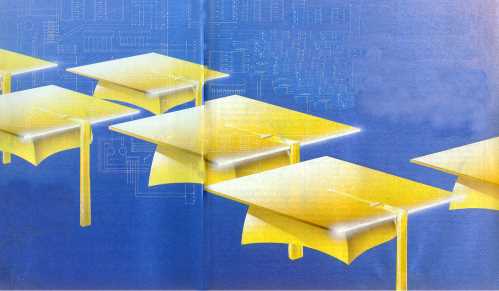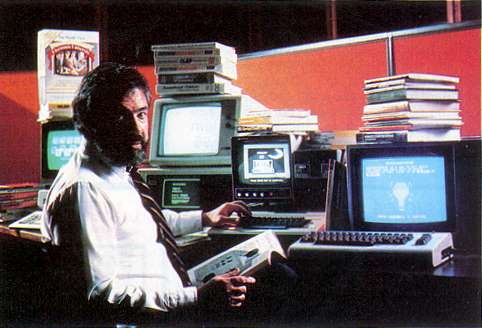The Elecronic University
Sharon Darling

Want to earn a coledge degree with-out leaving home? Or take self-improvement courses and sit in on lectures conducted by noted autorities-all through your computer? By enrolling in The Electronic University-a computerized correspondence school-you can do all that, and much more.
Leeann Pearce calls The Electronic University a "miracle." As she sits at the Commodore SX-64 in her home in West Des Moines, Iowa, Pearce is working toward a degree in computer technology to be granted by Thomas A. Edison College in New Jersey. Although she lives a thousand miles away and suffers from multiple sclerosis, Pearce is gaining the benefits of a college education by using an online educational system designed to work with home computers. Her husband, Frank, is using the same system after he comes home from work at night to earn a master's degree in business. And their eight-year-old daughter, Katie, who used to have trouble with math in school, has boosted her grades by taking an online math tutoring class. Katie is also halfway through a computer programming course and is registering for a class in literary arts this fall. One of the family's biggest problems now is arranging schedules so that each has enough time with the computer. But what really made the difference was the ability to take courses without leaving home. Because classes proceed at the student's own pace, Pearce was able to undergo surgery six months ago without interrupting her coursework. And academically, they find the classes as worthwhile as those taken the traditional way.
"I would say the courses are challenging enough," says Pearce. "They're like peanuts-you keep wanting to come back for more. And to bat around ideas with a Ph.D. is really wonderful to me."
What began as a project to teach people how to use modems has grown into a telecommunications network which allows students to use computers to earn high school and college degrees, take noncredit self-improvement courses, and "attend" seminars conducted by noted authorities. Graduate degrees in business administration have even been added to The Electronic University, which was developed by TeleLearning Systems, Inc. of San Francisco, a company founded in 1983 by entrepreneur Ron Gordon.
Close to 15,000 students are now taking classes and seminars in subjects ranging from economics to the subtleties of California wines. And the number of colleges and universities participating in The Electronic University has topped 1,700-all of which offer credit for courses taken through EU. Among the major institutions participating in EU are Cornell University, American University in Washing ton, D.C., Boston University, Virginia Tech, the New York Institute of Technology, Brigham Young University, the California State University system, the State University of New York, and many other state university systems. If enough coursework is completed to obtain a degree, the diploma is issued by the participating institution, not EU. It's up to students to make sure they meet the requirements of the college from which they want to receive the credit. EU has counseling services, however, to guide students through a degree program.
| Close to 15,000 students are now taking classes and seminars in subjects ranging from economics to the subtleties of California wines. And the number of colleges and universities participating in The Electronic University has topped 1,700. |
All it takes to enroll in EU is a computer (the system is compatible with the Commodore 64, IBM PC/PCjr, and Apple II series), a modem, and an enrollment package from EU. The package, a onetime investment, costs $79.95 for the Commodore 64 and $149.95 for Apple and IBM computers. If you don't own a modem, TeleLearning will sell you one for about $100.
Tuition ranges from $12 for a seminar up to $295 for some courses leading to a degree. In addition, students pay connect-time fees to participate in seminars and to access the more than 60 online databases. These fees range from about 17 to 80 cents per minute, depending on which database is accessed and when the call is placed. (A $15 monthly minimum is required.) To avoid long-distance charges, the phone calls are made to a local network number.
EU offers seven degree programs, including associate degrees in science, management, and the arts; bachelor's degrees in business administration and the arts; and three master of business administration (MBA) degrees-a general MBA and two specialized MBAs in technology/engineering management and individual financial planning.
Courses for college credit and self-improvement aren't the only services available. The enrollment package also offers tutoring programs for children, an electronic library with more than eight million books, counseling services, and courses in business and professional skills. Once students receive the enrollment package, they can sign up for whatever services they want. Credit courses begin every 60 days.
After students register, they're mailed an information packet on the courses they selected. The packet includes assignment outlines, a list of textbooks and other required materials, and the procedures of the institution delivering the course.
Students also receive a floppy disk containing a general introduction and a series of lessons. A typical lesson might include onscreen instruction, a textbook reading assignment, or other outside activities assigned by the instructor. Periodically, students must use their computer to transmit a progress report to their instructor via electronic mail (E-mail). They can also send questions about the course material and receive answers from the instructor by E-mail. Instructors respond to E-mail messages within 24 hours. In addition, students can schedule an online conference with the professor during designated office hours.
Some courses feature online exchanges with the instructor and even electronic forums with other students-a kind of class discussion via computer. Seminars also employ realtime conferences. Students sign on with their computers at the appropriate time, and the entire discussion session is carried out online.
Roughly 50 percent of a course's contents call for responses from the instructor. A typical class has 10 or 12 lessons; of those, half usually require students to write a response and send it to the instructor via modem, while the other half are "read-write" lessons. In that mode, students read material and type responses on the screen, but the results are not sent to the instructor. However, the instructor has the option of testing students on read-write material to check their progress.
EU does not administer any final exams. There is a practice exam available to students, but it doesn't replace taking a proctored exam at a nearby library or college, which is given by the school accepting the credits. Students also have the option of taking a CLEP (College Level Examination Program) test for credit, or an ACT PEP exam, which is given by the American College Testing Proficiency Examination Program.
Developing a college course to be taught by computer and keeping the material interesting is quite a challenge, says Tom Copley, an EU professor who formerly taught business courses at Antioch College in Ohio. Copley says he was "immediately intrigued" by the idea of an electronic college when he first read about TeleLearning last spring. Not only has he been a computer buff for the last 10 or 15 years, but he also has taken traditional evening school courses in the past. In addition to teaching classes, he's now deeply involved in developing courses for the online school.
"In the first place, you're working with a totally different media, and in order to be effective, you have to take advantage of its advantages. Unfortunately, the cathode ray tube is not nearly as expressive a medium [as books or lectures]." Therefore, he says, "you have to get high learning impact in a small amount of space."
Copley tries to focus on higher-level questions, the kind in which "the student has to synthe size a lot more information and draw more conclusions. I don't find myself using typical textbook jargon-words like describe, list, differentiate, etc. I ask for things that require a little more creative thought."
One less obvious advantage to long-distance learning that Copley has discovered is the opportunity to respond to students on a one-to-one basis by E-mail, even though he never sees the student in person. "So often [while teaching in a traditional college], I've had to respond to so many students at once. This is the opposite extreme. Every student gets an individual response, and it's not something off the top of my head, but a thought-out response."
But there are disadvantages, too. "You lose the group dynamics of working in a class environment; some people find that very stimulating. Of course, a lot of educators are critical of the class environment. They say the students are being spoon-fed, entertained. There is none of that in this system. Alternatively, though, there are a lot of things you can do, like screen layout, to make it interesting."

Ron Gordon, founder of The Electronic University.
Today's EU differs from the original focus of the university, which was to offer noncredit courses for personal improvement. After working with the U.S. Department of Education, TeleLearning realized there was an untapped market of people who could benefit from an alternative to traditional colleges.
When TeleLearning first approached universities with the idea of offering courses by computer, many professors were skeptical. Now, however, the school is gaining acceptance nationwide. By next year, founder Ron Gordon hopes to have 50,000 students enrolled. His ultimate goal is for the system to become the largest of its kind in the world, with millions of students.
Tom Copley predicts that alternatives like EU are "the wave of the future." He says the opportunity to take courses on your own time, at your own pace, and at the setting of your choice appeals to certain kinds of students, especially those in remote locations with no colleges nearby.
EU also tends to attract older students than traditional universities. The usual emphasis on under graduate students who are 18 to 22 years old doesn't always mesh with "people in their 30s who work maybe ten hours a day and may have a family," explains Copley. "Maybe it's been a lifelong dream of theirs to finish college, or maybe their job depends on them finishing a degree. For them, the traditional college life doesn't fit what they need. They're tired after work, or they want the flexibility they can't get from a regular university."
In the future, Copley is convinced The Electronic University will continue growing as more adults find computerized learning accessible, challenging, and rewarding. "So many marketing people focus on baby boomers, and that's where the market is-adults. And that's what undergraduate schools are finding out."
For more information about The Electronic University, contact TeleLearning Systems, Inc., 505 Beach Street, San Francisco, CA 94133,